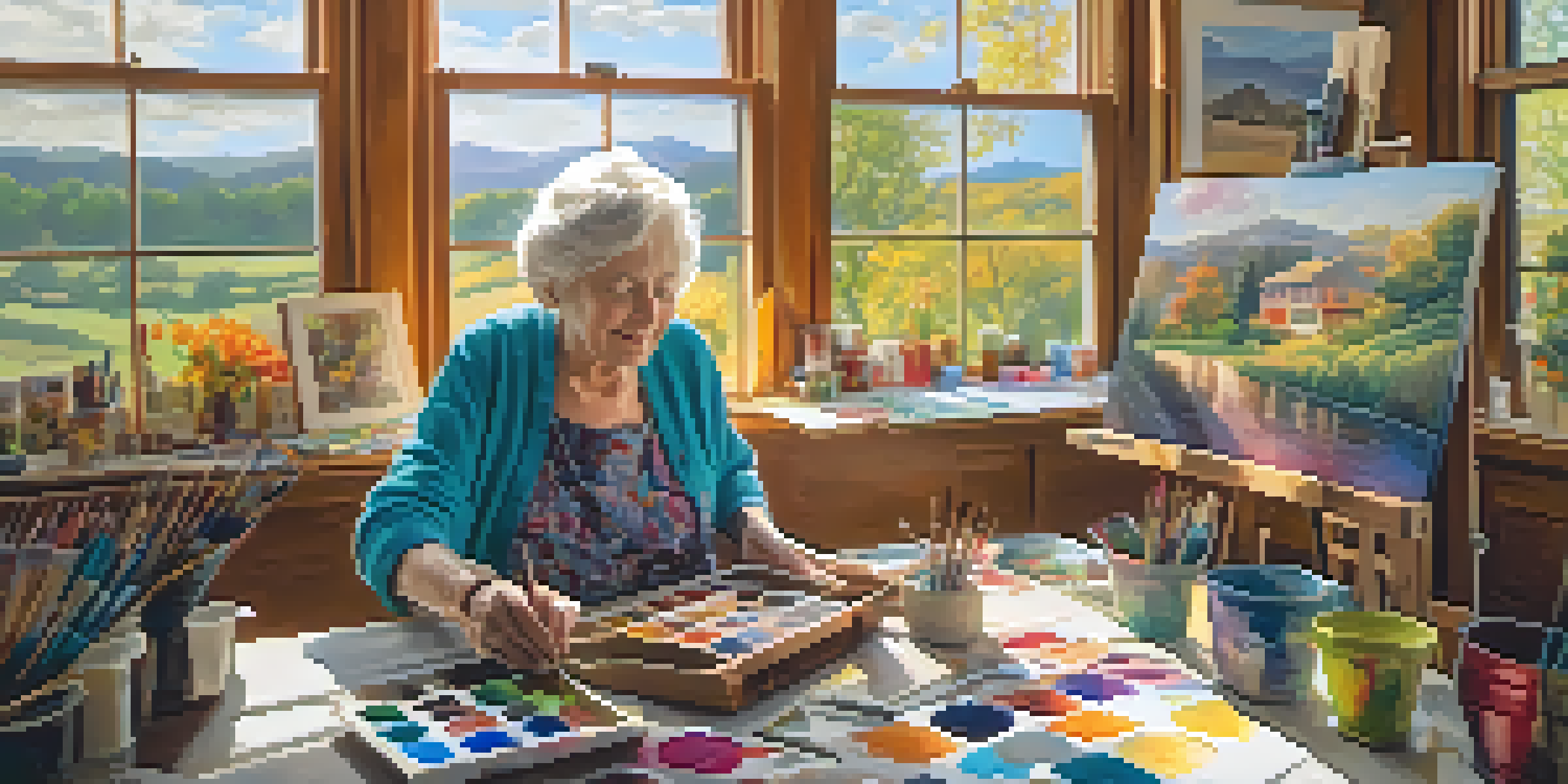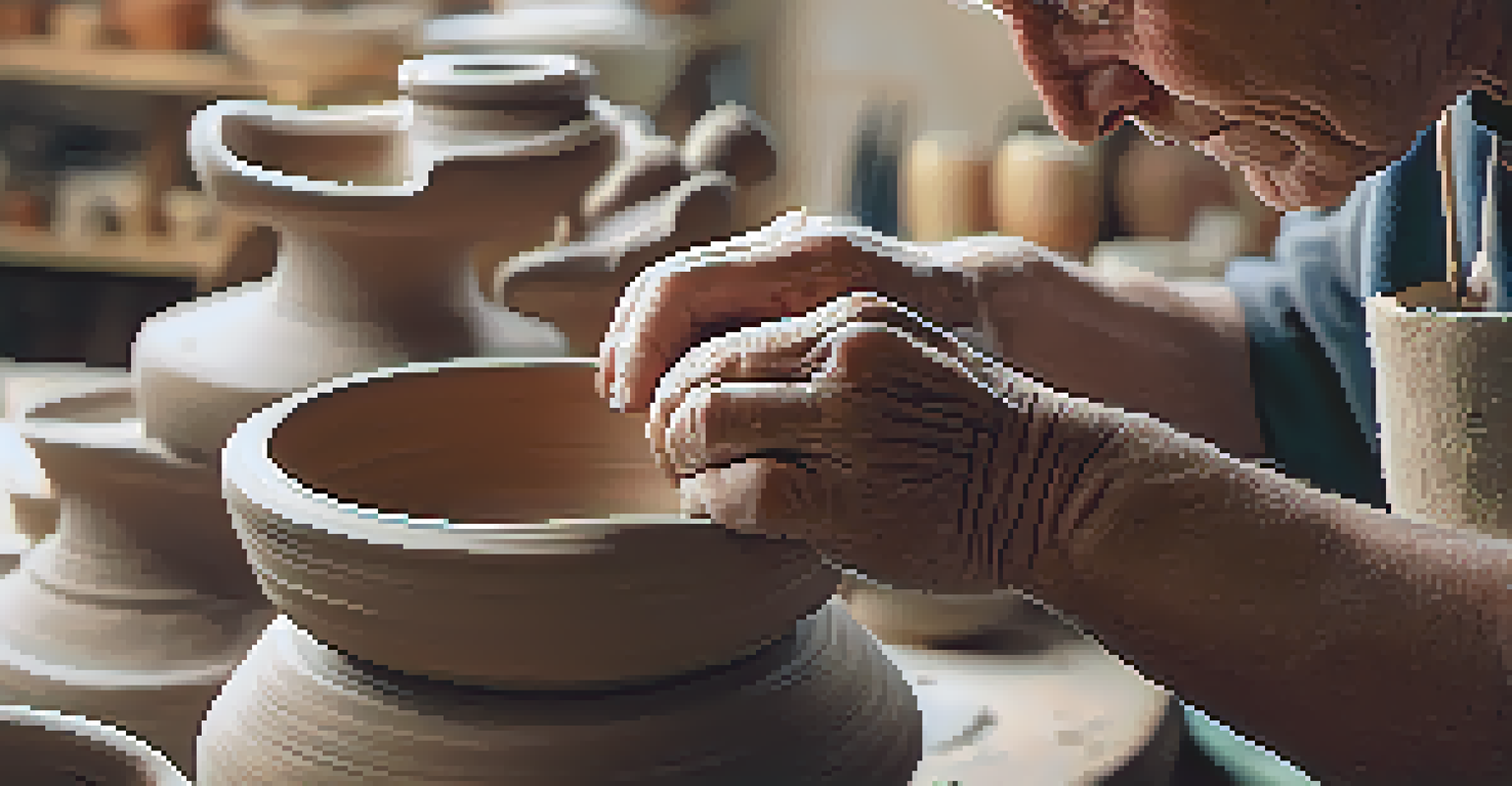The Benefits of Art on Mental Health in Aging Populations

The Connection Between Art and Mental Health
Art has long been recognized as a powerful medium for expression. For aging populations, engaging in artistic activities can significantly boost mental health. It provides a creative outlet that allows individuals to process emotions and experiences, especially in later life.
Art enables us to find ourselves and lose ourselves at the same time.
Research indicates that participating in art activities can reduce symptoms of anxiety and depression. When seniors express themselves creatively, they often find a sense of purpose and fulfillment. This can be particularly beneficial during times of transition, such as retirement or the loss of loved ones.
Moreover, art fosters social interactions, reducing feelings of isolation that many seniors experience. By joining art classes or community groups, older adults can connect with others who share similar interests, enhancing their overall well-being.
Art as a Tool for Cognitive Stimulation
Engaging in artistic activities not only uplifts spirits but also stimulates cognitive functions. Activities like painting, drawing, or sculpting require focus and concentration, which can help keep the mind sharp. This mental engagement is crucial as cognitive decline is a common concern in aging populations.

For instance, learning new techniques or experimenting with different mediums challenges the brain to adapt and grow. This process of learning can promote neuroplasticity, the brain's ability to reorganize itself, which is vital for maintaining cognitive health.
Art Enhances Cognitive Function
Participating in artistic pursuits helps stimulate cognitive functions, promoting mental sharpness and adaptability in aging populations.
Additionally, creating art encourages problem-solving and critical thinking. Seniors can explore their creativity without the pressure of performance, allowing them to rediscover joy in learning and self-expression.
The Therapeutic Power of Art Therapy
Art therapy is a structured approach that utilizes artistic activities to promote healing and well-being. Licensed art therapists guide individuals in using art as a means to communicate thoughts and feelings that may be difficult to express verbally. This is especially beneficial for seniors who may experience communication challenges.
Creativity takes courage.
Through art therapy, seniors can explore their emotions, reduce stress, and gain insights into their experiences. For example, a senior may create a painting that reflects their feelings about aging, enabling them to process these emotions in a safe environment.
Moreover, art therapy has been shown to improve mood and self-esteem. As seniors create meaningful works of art, they often feel a sense of accomplishment, which can combat feelings of worthlessness and despair.
Building Community Through Artistic Expression
Art has a unique ability to bring people together, fostering a sense of community among seniors. Group art projects or classes create opportunities for social interaction, collaboration, and shared experiences. This can help combat loneliness, a significant issue for many older adults.
When seniors engage in communal art activities, they often find comfort in shared creativity. They can bond over their artistic endeavors, exchanging ideas and inspiration while forming lasting friendships.
Art Boosts Seniors' Mental Health
Engaging in artistic activities can significantly improve mental health for seniors by providing a creative outlet for emotional expression.
Communal art initiatives also promote inclusivity and diversity. By participating in group projects, seniors from various backgrounds can share their stories and perspectives, enriching the community as a whole.
Mindfulness and Presence in Artistic Activities
Creating art encourages mindfulness, a practice that focuses on being present in the moment. For seniors, this can be a valuable tool for reducing stress and enhancing emotional regulation. The act of painting, sculpting, or crafting allows them to immerse themselves in a calming, creative process.
Mindfulness through art can also improve emotional resilience. As seniors focus on their artistic tasks, they often find a reprieve from worries and anxieties. This mental break can lead to improved overall mood and mental clarity.
Furthermore, the repetitive motions involved in many art forms, such as knitting or watercolor painting, can have a meditative effect. This repetitive nature allows seniors to enter a state of flow, where they can lose themselves in the creativity.
Art as a Medium for Life Reflection
Art can serve as a powerful medium for reflection, allowing seniors to explore their life experiences and memories. Creating art that represents significant moments can help them process their past and make sense of their journey. This retrospective aspect can be both therapeutic and validating.
For instance, a senior might create a collage of important life events, which can open dialogues about their experiences with family and friends. This type of creative expression can foster deeper connections and understanding between generations.
Community Through Artistic Expression
Group art activities foster social connections among seniors, combating loneliness and promoting a sense of belonging within the community.
Additionally, reflecting on life through art can enhance a sense of legacy. Seniors often find satisfaction in leaving behind a tangible representation of their life story, providing a source of pride and fulfillment.
Accessing Art Resources and Programs for Seniors
Many communities offer resources and programs specifically designed for seniors to engage with art. Local art centers, libraries, and senior centers often host classes and workshops that cater to varying skill levels. These programs are a great way for older adults to explore their creativity in a supportive environment.
Additionally, online platforms have emerged as valuable resources for seniors who may prefer to explore art from home. Virtual classes and tutorials can help them learn new techniques and connect with instructors and peers globally.

Moreover, many art organizations provide discounted or free resources for seniors, making art accessible to everyone. This inclusivity ensures that older adults can experience the mental health benefits of art, regardless of their financial situation.